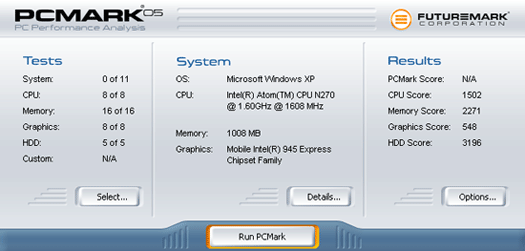PCMark 05 and LAME MT Performance
For our next round of synthetic benchmarks, we ran the CPU, Memory, Graphics and HDD performance modules built into Futuremark's PCMark05 suite. Since the Eee Box is pre-configured with Windows XP, we were unable to run our current standard PCMark Vantage test suite for WIndows Vista. However, the following tests should at least give you a simple baseline.
|

Asus Eee Box - Stock Speed

Asus Eee Box - Maximum Overclock
First, with respect to these performance metrics, a good watermark might be a Core Duo T2400 (1.83GHz) CPU score that we've historically seen around the 4200 mark, with a DDR2-667 based memory score of around 2800. Obviously the Eee Box and its ultra low power Atom processor at 2.5W, is going to clock in quite a bit lower than a true mobile dual core notebook platform.
Finally, we've also provided you a quick-take look at performance with our Eee Box overclocked to 1.75GHz. With a little over a 9% clock speed increase, we pulled down an incremental 9.5% increase in PCMark05 CPU benchmark performance and our graphics and memory score perked up a bit as well.
|
In our custom LAME MT MP3 encoding test, we convert a large WAV file to the MP3 format, which is a popular scenario that many end users work with on a day-to-day basis to provide portability and storage of their digital audio content. LAME is an open-source mid to high bit-rate and VBR (variable bit rate) MP3 audio encoder that is used widely around the world in a multitude of third party applications. In this test, we created our own 223MB WAV file (a hallucinogenically-induced Grateful Dead jam) and converted it to the MP3 format using the multi-thread capable LAME MT application in single and multi-thread modes. Processing times are recorded below, listed in seconds. Shorter times equate to better performance.

Here the Eee Box posts slightly better scores in multi-threaded mode versus the Atom 230 reference system but slightly slower single threaded scores as well. The VIA Nano reference system does chalk up a considerably faster time, especially since it can only run in single threaded mode. Then again, it also consumes orders of magnitude more power at 18W versus the 2.5W Atom N270 powering the Eee Box.






